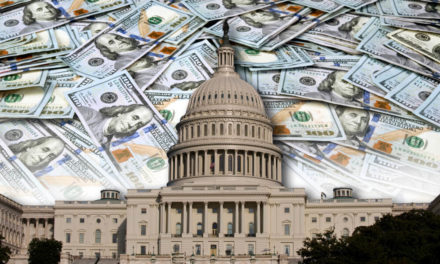Asking for Trouble
The U.S. economy and financial markets often behave in confounding ways. Something that appears to be obvious never materializes. And something of little apparent prospect becomes a major theme.
With little indication, for example, gross domestic product (GDP) may expand in the face of menacing economic fundamentals. Similarly, an extended bear market rally may appear to be a new bull market.
What’s more, when central planners have a heavy hand in extreme market intervention the distortions and false signals are especially puzzling. Prices may avoid logic for extended periods of time.
Will Federal Reserve Chair Jay Powell successfully pilot a soft economic landing?
That’s what Marriott CFO Leeny Oberg believes. On the company’s earnings call this week she said:
It now seems more likely that the U.S. economy could have a soft landing.”
What you’ve seen lately is still really strong employment numbers, increased expectations for GDP growth. You’re also seeing that inflation is calming down, which I think … helps everybody think, ‘Okay, you know what? We could actually have kind of a soft landing without a huge downfall.
Here at the Economic Prism, we’ll believe it when we see it. And even then, we won’t trust our eyes.
Believing something is a done deal before it has come to pass is asking for trouble. If you recall, in 2003, six weeks after invading Iraq, President George W. Bush gave a speech in front of a White House fabricated banner that read, “Mission Accomplished”.
The mission, we all know, was far from over. And what exactly was accomplished remains a mystery. Do you know what was accomplished after nearly two decades in Iraq?
Shortsighted Thinking
The requisite financial panic and economic depression that’s coming will be hard. Not soft. In fact, it will be much, much harder than many people expect.
By this, it is likely today’s enthusiasm for a soft economic landing will ultimately be remembered for its absurdity. There’s nothing soft about reconciling a $5 trillion debt binge, which was piled on top of a 50-year debt binge.
The reconciliation will come, no doubt, all in good time. Here’s why…
Zero interest rate policy from 2008 to 2022 — with a brief hiatus in 2017-18 — took time to show up in the CPI. Though its effects were abundantly present in stock, bond and real estate prices. There was a lag in CPI inflation.
Nonetheless, the Fed’s ZIRP eventually resulted in consumer price inflation hitting a 40-year high. Then, to clean up the mess of its making, starting in March 2022, the Fed began hiking rates. From near zero in March 2022 to a range of 5.25% to 5.5% today.
Apart from the collapse of Silicon Valley Bank and several other banks, like First Republic, the rate hikes have yet to cause a major financial crisis. Soft landing advocates see this as justification for their position.
We believe they are shortsighted in their thinking. Just as ZIRP took many years to show up in consumer prices, the consequences of Fed rate hikes will also take time to manifest. And how these consequences ultimately appear will be irregular and erratic.
As borrowing costs increase, different areas of the economy react in different ways. Sometimes they react in ways that are strange and unexpected.
Low-Mortgage Handcuffs
Take residential real estate, for instance. Typically, this market is very sensitive to rising interest rates. Over the last two years, 30-year fixed rate mortgages have jumped from 2.65% to 7%. At the same time, house prices remain near their all-time highs and are completely unaffordable.
First time homebuyers, looking to attain the American dream, must earn 13% more than last year to afford a starter home. How many potential homebuyers received a 13% raise from last year?
Not many, we presume.
Hence, with houses being completely unaffordable in many areas of the country, why hasn’t an epic housing market crash commenced?
The answer can be traced back to Fed engineering, and its efforts to plan the economy by fixing the price of credit.
All homeowners with half a brain used the Fed’s cheap credit in 2021 to refinance at 30-year fixed rate mortgages below 3%. Now, they cannot afford to sell and move.
What is happening, in short, is that homeowners are wearing low-mortgage handcuffs. They are locked in and stuck where they are. They can’t afford to move. And even if they can, they do not want to sell their home and lose their sub-3% mortgage rate.
As a result, the volume of starter homes for sale has plummeted. According to Redfin, new listings of starter homes for sale in June have fallen 23% from one year ago. Consequently, sales of previously sold houses have fallen 17% over this period.
Do you see what’s going on?
How the Fed Retarded the Residential Real Estate Market
Even though houses are completely unaffordable, prices remain high because the supply is ultra-constrained. The Fed, in essence, retarded the residential real estate market. Only well-intentioned central planners could accomplish such a feat.
This has several consequences. One, the overpriced housing market is unable to clear. Because of this, the housing market crash is moving slower than molasses going uphill in January.
How this all plays out over the next decade is unclear. What will happen when the economy slips into a recession and the unemployment rate spikes up?
Will a massive population of unemployed homeowners be forced to sell under duress? Will they discover that the monthly rent on a substandard apartment is more than what they were paying on their mortgage?
These are the sorts of unfavorable decisions that people get to make when central planning has stood the market on its head. But that’s not all…
A dynamic, innovative economy is characterized by people going where the opportunities are. The best and the brightest blaze their trail to places where their talents are most rewarded. And that’s where the magic happens.
Together, these minds create new technologies, new products, new industries, new jobs and new ways of doing things. They drive the economy forward. They create new wealth.
What happens when people, anchored by low-mortgage handcuffs, stay put?
Alas, the dynamic economy that should have been never comes into existence. The economic activity, the wealth creation, which should have happened is cancelled before it even starts.
GDP growth slows. Living standards stagnate.
Most critical, the infectious hum and buzz of productive energy is overcome with apathy.
[Editor’s note: Is the Pentagon secretly provoking China to attack Taiwan? Are your finances prepared for such madness? Answers to these important questions can be found in a unique Special Report. You can access a copy here for less than a penny.]




